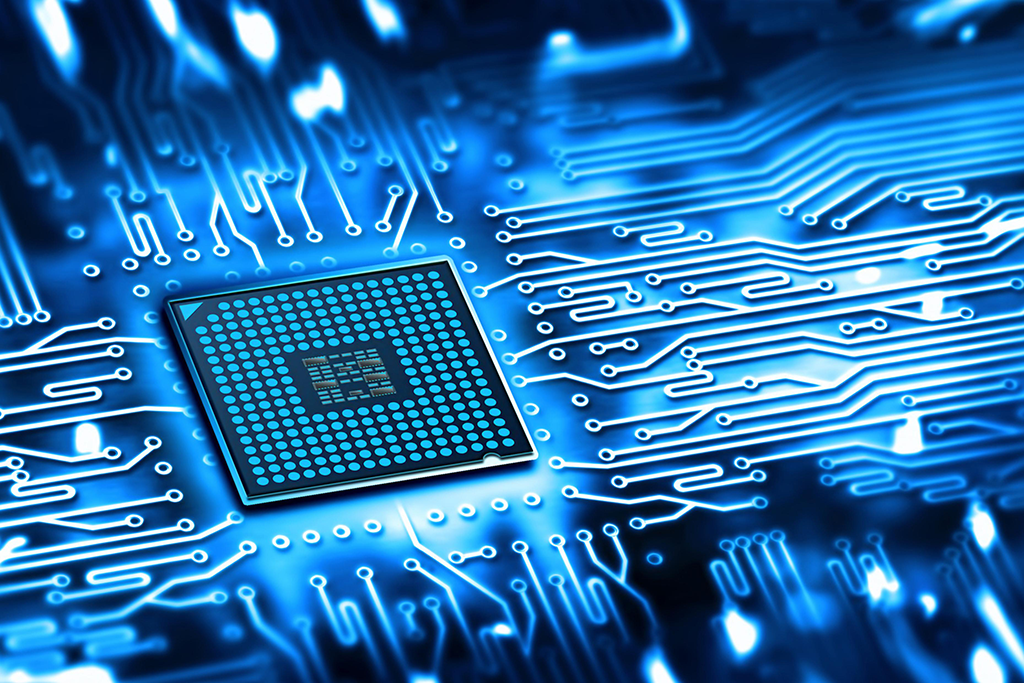
Disclaimer: Copyright infringement not intended.
Context
- The Union Cabinet approved three semiconductor plant proposals, aiming to bolster India's semiconductor manufacturing ecosystem.
- The projects entail an estimated investment of Rs 1.26 lakh crore and are expected to significantly contribute to India's electronics manufacturing sector.
Details
Semiconductor Fab in Gujarat
- Tata Electronics and Taiwan's Powerchip Semiconductor Manufacturing Corp. (PSMC) will establish India's first semiconductor fabrication plant (fab) in Dholera, Gujarat.
- Projected Cost: Rs 91,000 crore.
- Capacity: 50,000 wafers per month.
- Focus Areas: High-performance compute chips with 28 nm technology, power management chips for various sectors including electric vehicles, telecom, and consumer electronics.
Semiconductor ATMP Unit in Assam
- Tata Semiconductor Assembly and Test Pvt Ltd (TSAT) will set up a semiconductor unit in Morigaon, Assam.
- Projected Cost: Rs 27,000 crore.
- Capacity: 48 million chips per day.
- Segments Covered: Automotive, electric vehicles, consumer electronics, telecom, mobile phones, etc.
Semiconductor ATMP Unit in Gujarat
- CG Power, in partnership with Renesas Electronics Corp., Japan, and Stars Microelectronics, Thailand, will establish a semiconductor unit in Sanand, Gujarat.
- Projected Cost: Rs 7,600 crore.
- Capacity: 15 million chips per day.
- Segments Covered: Consumer, industrial, automotive, and power applications.
Employment and Economic Impact
- The chip fab scheme is expected to employ 26,000 people directly and nearly 1 lakh indirectly.
- These units will generate direct employment of 20 thousand advanced technology jobs and about 60 thousand indirect jobs, accelerating employment creation in downstream industries.

Semiconductor Industry Landscape in India
Current Status and Growth Potential:
- According to the India Electronics and Semiconductor Association (IESA), semiconductor consumption in India reached US$21 billion in 2019, growing at a rate of 15.1%.
- India's semiconductor consumption is projected to exceed USD 80 billion by 2026 and USD 110 billion by 2030.
Global Dominance and Key Players:
- Major semiconductor manufacturing countries include the United States of America, Taiwan, South Korea, Japan, the Netherlands, and emerging producers like Germany.
Challenges Faced by India:
- India lags in establishing semiconductor wafer fabrication (FAB) units due to a weak ecosystem and resource shortages compared to more competitive bases like China and Vietnam.
- Semiconductor FAB units require significant investments, water for production, uninterrupted electricity supply, high operating costs, and frequent technology upgrades.
India's Strategic Focus:
- India's contribution to the semiconductor industry focuses on leveraging its technical competencies in research and development (R&D) and design.
- The country benefits from a skilled talent pool in IT design and R&D engineers, allowing it to excel in areas such as R&D, design, and innovation.
India Semiconductor Mission (ISM)
- Launched in 2021 with a financial outlay of Rs76,000 crore under the Ministry of Electronics and IT (MeitY).
- ISM operates as an Independent Business Division within Digital India Corporation, tasked with catalyzing the India Semiconductor ecosystem.
Objectives of ISM:
- Formulate a comprehensive long-term strategy for developing sustainable semiconductor and display manufacturing facilities.
- Facilitate the adoption of secure microelectronics and develop a trusted semiconductor supply chain.
- Enable growth of Indian semiconductor design industry through support mechanisms for startups.
- Promote indigenous Intellectual Property (IP) generation and facilitate Transfer of Technologies (ToT).
- Establish mechanisms to harness economies of scale and enable cutting-edge research in semiconductors.
- Foster collaborations and partnership programs with national and international agencies, industries, and institutions.
Implementation and Initiatives:
- ISM serves as the nodal agency for efficient implementation of semiconductor development programs.
- Advisory board consisting of leading global experts provides guidance and expertise.
- Engages stakeholders and attracts investments to the semiconductor and display ecosystem in India.
Financial Support and Schemes:
- INR 13 crore released to ISM to date.
- Modified schemes introduced to attract investments in semiconductor fabs and display fabs in India.
- Scheme for setting up Semiconductor Fabs offers fiscal support of 50% of project cost.
- Scheme for setting up Display Fabs extends fiscal support of 50% of project cost.
- Scheme for Compound Semiconductors, Silicon Photonics, Sensors Fab, and Semiconductor ATMP facilities offers fiscal support of 50% of capital expenditure.
- Semicon India Future Design (DLI) Scheme provides financial incentives and infrastructure support for semiconductor design.
- Modernization of Semi-Conductor Laboratory, Mohali approved as a brownfield Fab to enhance semiconductor manufacturing capabilities.
About Semiconductors
- Semiconductors are materials with electrical conductivity between conductors (metals) and insulators (non-metals). They have a bandgap that lies between the valence and conduction bands, allowing them to conduct electricity under certain conditions.
- Silicon (Si) is the most commonly used semiconductor material due to its abundance, stability, and well-understood properties. Other semiconductor materials include germanium (Ge), gallium arsenide (GaAs), and silicon carbide (SiC).
Semiconductor Physics:
- Band Theory: Semiconductors exhibit a bandgap, which is the energy difference between the valence band (filled with electrons) and the conduction band (empty of electrons). Electrons can move from the valence band to the conduction band when provided with sufficient energy.
- Doping: Semiconductors can be doped with impurities to alter their electrical properties. N-type doping introduces donor atoms (e.g., phosphorus) that provide extra electrons, while P-type doping introduces acceptor atoms (e.g., boron) that create electron deficiencies or "holes."
Semiconductor Devices:
- Diodes: Semiconductor diodes are two-terminal devices that allow current to flow in one direction while blocking it in the opposite direction. They are used in rectifiers, voltage regulators, and signal demodulators.
- Transistors: Transistors are three-terminal devices that amplify or switch electronic signals. Common types include bipolar junction transistors (BJTs) and field-effect transistors (FETs), which include metal-oxide-semiconductor FETs (MOSFETs) and junction FETs (JFETs).
- Integrated Circuits (ICs): ICs are semiconductor devices that contain thousands to billions of electronic components, such as transistors, diodes, and resistors, fabricated on a single chip. They are the building blocks of modern electronic systems.
Semiconductor Fabrication:
- Semiconductor fabrication, also known as semiconductor manufacturing or lithography, involves multiple steps to create integrated circuits on semiconductor wafers. These steps include wafer preparation, deposition, lithography, etching, doping, and metallization.
- Advanced techniques such as extreme ultraviolet lithography (EUV), FinFET technology, and multi-patterning are used to achieve smaller feature sizes and higher device densities.
Applications of Semiconductors:
- Electronics: Semiconductors are essential components in electronic devices such as computers, smartphones, televisions, and digital cameras. They enable the processing, storage, and transmission of information.
- Power Electronics: Power semiconductor devices, including diodes, thyristors, and insulated gate bipolar transistors (IGBTs), are used in power conversion, motor control, and renewable energy systems.
- Optoelectronics: Optoelectronic devices, such as light-emitting diodes (LEDs), laser diodes, and photovoltaic cells, utilize semiconductors to generate, detect, or control light.
Emerging Trends in Semiconductors:
- Internet of Things (IoT): The proliferation of IoT devices is driving demand for low-power, high-performance semiconductors suitable for wireless communication, sensing, and data processing.
- Artificial Intelligence (AI): AI applications, including machine learning and deep learning, require specialized semiconductor chips optimized for parallel processing and neural network acceleration.
- Quantum Computing: Quantum computing relies on quantum bits (qubits) implemented using semiconductor-based quantum devices. Research in this field aims to develop quantum processors with exponentially higher computational power than classical computers.

About Semiconductor Fabrication
- Semiconductor fabrication, also known as semiconductor manufacturing or semiconductor lithography, is the process of creating integrated circuits (ICs) or chips on a semiconductor wafer.
- This process involves multiple intricate steps, including deposition, lithography, etching, and doping, to create the complex patterns and structures that form the basis of electronic devices.
Semiconductor Materials:
- Silicon is the most commonly used semiconductor material due to its abundance, stability, and suitable electrical properties.
- Other semiconductor materials include gallium arsenide (GaAs), indium phosphide (InP), and silicon germanium (SiGe), each offering specific advantages for different applications.
Semiconductor Fabrication Process:
- Wafer Preparation: The fabrication process begins with the preparation of semiconductor wafers, typically made of silicon. These wafers undergo cleaning, polishing, and inspection to ensure their quality and uniformity.
- Deposition: Thin films of various materials, such as silicon dioxide (SiO2) or metal layers, are deposited onto the wafer surface using techniques like chemical vapor deposition (CVD) or physical vapor deposition (PVD).
- Lithography: A crucial step in semiconductor fabrication, lithography involves transferring intricate patterns from a mask or photomask onto the wafer surface using light exposure and photoresist materials.
- Etching: After lithography, excess material is removed from the wafer surface through etching processes, which can be either wet (chemical) or dry (plasma) etching, to define the desired features.
- Doping: Doping introduces impurities into specific regions of the semiconductor to modify its electrical properties. Dopants such as boron or phosphorus are introduced using techniques like ion implantation or diffusion.
- Annealing: Thermal processes, including annealing, are employed to activate dopants, repair crystal lattice defects, and improve the electrical characteristics of the semiconductor material.
- Metallization: Metal layers are deposited onto the wafer surface to form interconnects between different components of the integrated circuit, enabling electrical connectivity.
- Packaging: Once fabrication is complete, individual chips are separated from the wafer and encapsulated in protective packaging, ready for integration into electronic devices.
Advanced Semiconductor Technologies:
- FinFET Technology: FinFET (Fin Field-Effect Transistor) is a 3D transistor structure that offers improved performance and power efficiency compared to traditional planar transistors.
- Extreme Ultraviolet Lithography (EUV): EUV lithography utilizes short-wavelength light to achieve higher resolution and enable the fabrication of smaller feature sizes, crucial for advanced semiconductor nodes.
- Multi-Patterning Techniques: To overcome the limitations of optical lithography, multi-patterning techniques such as double patterning or triple patterning are employed to achieve sub-nanometer feature sizes.
Conclusion
Semiconductor fabrication is a complex and highly sophisticated process that underpins the development of modern electronic devices. Continued innovation in fabrication techniques, materials science, and device architectures will drive the semiconductor industry forward, enabling the realization of next-generation electronics with enhanced performance, functionality, and energy efficiency.
|
PRACTICE QUESTION
Q. Collaborations with global semiconductor leaders and investment in infrastructure and talent development are key strategies to strengthen India's position in the semiconductor industry. Discuss. (150 words)
|




![]()










